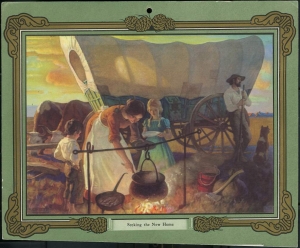
N. C. Wyeth (1882-1945)|Seeking the New Home, 1935-6|Scanned from a calendar mount|Collection of the Brandywine River Museum
There are two layers of action in this N. C. Wyeth calendar illustration, Seeking the New Home from 1935-36: the inward turning grouping of the mother and children all focused around the cook fire; and the outward turned man, dog, and oxen. Even though the oxen are foraging their dinner, they were expected to react to a change in activity around them. In contrast to the paired passive beasts behind the family grouping, the man and dog are considerably more alert, each scanning the horizon in different directions for unexpected movement. Dinner is being produced at the fire in a cast-iron fry pan with three tall legs, called a spider, and a kettle also with three legs, hanging from an iron s-hook balanced on a set of cooking irons. N. C. Wyeth had both the spider and kettle in his studio collection and they can still be seen in his studio which is part of the Brandywine River Museum collections.
In order to be viewed on the Great Plains with a mountainous backdrop, this family has to have been on the trail for weeks. I love the blinding whiteness of the boy’s shirt and the wife’s apron. Indeed the family’s clothing is pristine and clean despite the rising smoke and ash from the wood fire and the inevitably hard life and difficult times experienced while riding and walking across the Great Plains. The single Conestoga wagon does not appear to be part of a wagon train, even though traveling with other wagons was typically a safer way of making the journey. But in the case of this illustration, a group of wagons and settlers would not have rendered such a compelling and appealing picture of the nineteenth century families who made their way from the eastern states of the country through the unsettled countryside to their new home. It is interesting though that the canvas of the Conestoga wagon’s cover is patched but also clean.
This image was reproduced on advertising calendars by various insurance companies although the arrangements for its commissioning are unknown. How appropriate to make such an optimistic illustration of settlers on their journey across the plains during the period of the American dust bowl disaster. Also known as the “dirty thirties” this period of severe dust storms generated extreme damage to the American and Canadian prairie landscape. It was caused by a period of severe drought after decades of deep plowing of the topsoil of the Great Plains. Without the native grasses, which normally conserved the top layer of the ecosystem, the mixture of drought and high winds scrubbed the land.
The model family of Wyeth’s illustration helps to convey the essential sturdiness of the settlers and implies a similar characteristic for America’s 20th century settlers, or resettlers, those displaced from the dust bowl who were also making their way west to a new and better life. During this period of extreme uncertainty and economic collapse, N.C. Wyeth created an optimistic image of family solidarity, sufficiency, and hope in an as yet pristine landscape set against a storm-free sky.
July 30, 2009
By Joyce K. Schiller, Curator, Rockwell Center for American Visual Studies
Norman Rockwell Museum






